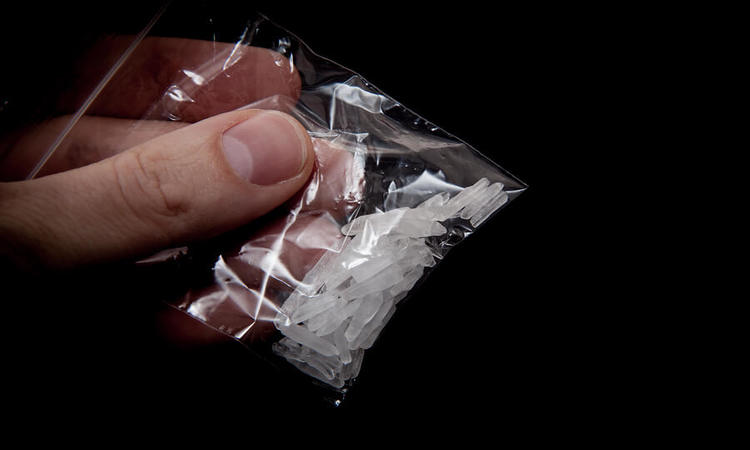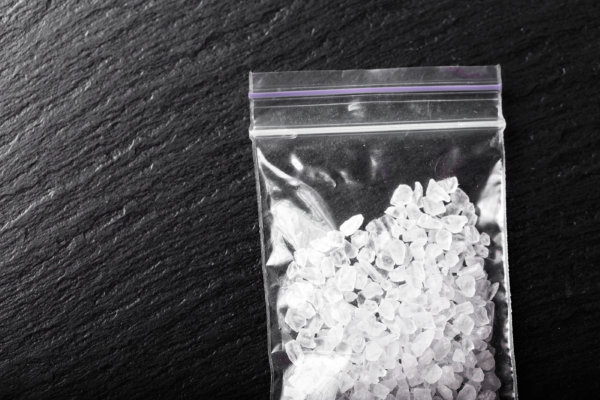
How Long Does Meth Stay In Your System? Meth has a half-life of about 12-34 hours, meaning that within this time, the concentration of meth in the blood is reduced by about half. So how long does meth stay in your system? Meth can be detected by urine tests for three days after the last use, but depending on individual factors, such as the following, this length of time will vary:
- Personal rate of metabolism
- Frequency of use
- Amount last used
- Purity/potency of drug used
- Kidney and liver functionality
How Long Does Meth Stay in Your System: How Meth is Metabolized

When a person uses meth, the body starts to process it immediately as it circulates through the blood. Some of this is converted into pure amphetamine.
After a few hours, the body begins to metabolize both the meth and amphetamine and the substances start their journey through the liver and kidneys, soon to be partially excreted through urine.
Some research has shown that as much as half of a meth dose can be eliminated from the body in its original form – moreover, not having been metabolized, nor the user having experienced any effects at all from this portion.
Meth Side Affects
In addition to desired effects of increased energy and euphoria, meth users may experience the following adverse symptoms:
- Sweating
- Diminished appetite
- Teeth grinding (bruxism)
- Itching
- Disordered thoughts
- Dry mouth
- Mood swings
- Nausea and vomiting
- Diarrhea Paranoia and delusions
- Hallucinations and psychosis
Long-term meth use can also increase the risk of heart disease, cognitive defects, neurotoxicity, and early death. Meth use also significantly raises the risk of hemorrhagic stroke, even in young people
Meth use also wreaks havoc on oral hygiene and many long-term meth users end up with tooth decay from dry mouth and even dentures.
Snorting meth, like cocaine, also increases a user’s risk of nosebleeds, infections, and irreversible damage to the nasal septum and surrounding tissues.
Injecting meth, on the other hand, can result in damage to the skin and veins, including abscesses and infections.
Signs of Meth Use
If you suspect someone you know is using meth, look for the following warning signs:
- General hyperactivity
- Skin picking
- Meth sores (from picking at skin)
- Meth mouth (severe tooth decay)
- Loss of appetite and weight loss
- Dilated pupils
- Rapid eye movement
- Uneven sleeping patterns that can include periods of being awake for days or even weeks following by long bouts of sleeping
- Twitching, facial tics, jerky movements, and exaggerated mannerisms
- Talking constantly
- Outbursts or mood swings
- Paranoia
Also, people using meth frequently may have an unkempt appearance and tend to neglect critical personal responsibilities such as child-rearing, housekeeping, and employment.
Polysubstance Abuse
Many meth users also use other drugs or alcohol, which is far more dangerous than abusing meth alone. For example, using meth in combination with another stimulant can lead to sudden death by heart attack. Using meth in conjunction with a central nervous system (CNS) depressant, on the other hand, can lead to unpredictable and possibly life-threatening complications such as respiratory arrest.
It’s also becoming increasingly common to find meth on the streets that is tainted with other drugs, such as fentanyl, a powerful synthetic opioid painkiller similar in effect to heroin, but far more potent. This is especially troubling because the user often does not know that fentanyl is present, and often has little or no tolerance for opioids.
While overdosing on meth is rarely fatal, overdosing on fentanyl-laced meth can cause death when the primary effects of meth wear off and fentanyl is still active in the body.
Treatment for Meth Abuse
Unlike other substances such as opioids and alcohol, there is no medication-assisted treatment for meth withdrawals. However, undergoing a medical detox offers patients a clinically-supervised withdrawal period in which vital signs can be monitored for complications.
After a short detox period, patients should participate in one of our addiction treatment programs, either on a partial hospitalization or outpatient basis. Both programs offer vital therapeutic elements needed for recovery, including psychotherapy, individual and group therapy, counseling, and holistic practices such as meditation and art therapy.
After treatment has been completed, patients can still participate in an aftercare program in which aftercare planning specialists help them locate therapeutic support services in their area such as ongoing behavior therapy, counseling, and peer group meetings.
We Are Addiction Specialists
Our staff includes addiction specialists and other healthcare providers trained to enact individualized programs that treat the symptoms of addiction and withdrawal. We are dedicated to providing clients with the tools, support, and care they so desperately need to achieve a full recovery and begin to experience long-term wellness and sobriety.
If you or your loved one is suffering from substance abuse such as meth, please seek contact us as soon as possible to discover how we help people free themselves from the chains of addiction for life!
Related: What is Tweaking?